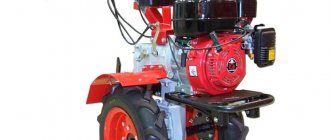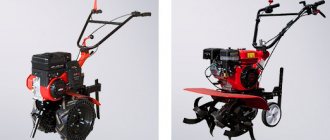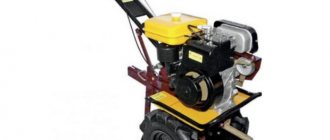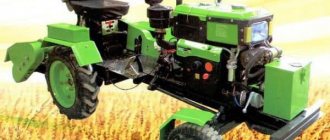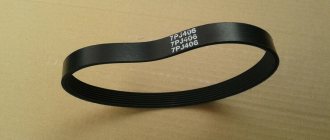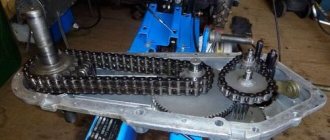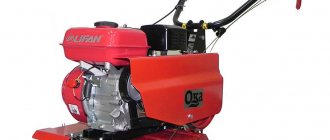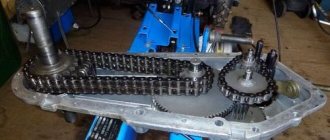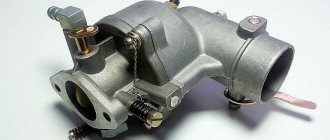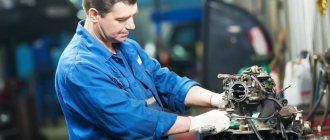Losiash62 › Blog › Choosing a walk-behind tractor, or 30 years of evolution wasted.
Hello!
Although the D2 website is dedicated to cars, you can’t find anything on user blogs. You will be surprised more than once, but I have never found comprehensive information on walk-behind tractors. Forums for collective farmers and farmers are long and fruitless, and typical articles from copywriters - “how to choose and buy a walk-behind tractor” did not inspire confidence because they are game! (Friends, I understand that this topic is boring and far from the interesting articles of Drive2, but for those who master the entire text, there is a bonus at the end of the publication!). In the first case, on thematic forums, they start asking you how many piglets you have this year, and they try to find out how your harvest was in the past. And online publications on custom topics give themselves away from the first lines, because they openly begin to “spill water”, inflating the cost of the article, and telling everything from the creation of the world to the present day. Moreover, what’s offensive to me, as a lover of my writing and an engineer by training, is the outright technical blunders in such publications. Moreover, trying to somehow find useful information, after half an hour of scrolling through the network, my head is spinning. In general, this is also not an option.
Therefore, bit by bit, I put together the little that I found on the Internet, watched on YouTube, and in which I have many years of practical experience. It was decided to pour out these efforts on the pages of a personal blog. After all, there is a problem, but there are not many solutions. In case anyone needs this kind of information, I will be glad if I can help.
So, from the moment the engine was invented, man sought to attach it somewhere. In some cases, this “somewhere” looked contradictory and unusual, but in essence it did its job and spread around the world in millions of copies. The first patent for a walk-behind tractor was issued in Germany, already in 1912. The inventors of this miracle and patent holders are considered to be Conrad Von Meyenburg and the Siemens-Schuckertwerke company. They produced aircraft engines, self-propelled strollers, agricultural equipment and household appliances. In essence, and since then nothing has changed. In fact, this is a front-wheel drive module, also known as drive wheels. In the USSR they were called a single-axle tractor, or a pedestrian tractor.
Moreover, you should immediately dot the I’s and determine what is a walk-behind tractor and what is a motor-cultivator. If it is initially only for milling and without wheels, then it is a cultivator. For example, the most common motor cultivator is the “Mole”. But if this is a wheeled vehicle capable of pulling a plow, or a trailer, or some other attachment, but at the same time allows the wheels to be replaced with cutters and carries out milling, then this is a walk-behind tractor. Moreover, even though the first walk-behind tractor was manufactured in the USSR only in 1948, somewhere in Perm, the term “Moto-block” began to be used only in the 80s. When various design bureaus and research institutes began to intensively provide industrial similar small-scale mechanization. All walk-behind tractors are divided into light, medium, heavy and super-heavy. If the first two categories contain only an engine and transmission, then the last two may already have a power take-off shaft, or a simple gear pump for hydraulics. For obvious reasons, with a typical area of 6 acres for most city dwellers, the most common walk-behind tractors are light and medium. They’re heavy, it’s unnecessarily bulky, it won’t fit in a Lada, and there’s nowhere to accelerate. In general, my choice, like that of most Russians, went towards the middle class of walk-behind tractors. But it turned out to be not so simple.
Background. In our family, the Cascade walk-behind tractor has been alive and well since the early 90s. Early, with a hood and false headlight. What a sight for sore eyes!
Beautiful yellow color, with a red gearbox and toothy wheels. He is over 25 years old, and 10 years ago he underwent an operation to replace the carburetor, starter, and then the engine with a Chinese Lifan (assembled), and five years earlier the transmission parts were replaced. Moreover, it is worth noting that there were no adapter plates, and all connections were made on the knee. Only then did walk-behind tractors with already installed Chinese and American engines go on sale intensively. It’s a pity that we had to abandon the false hood and headlights, but it is what it is. Time broke his ambition, he became brutal, covered with rust, and became stiff. He worked tirelessly with cutters in all our family’s vegetable gardens, sometimes gnawing into virgin lands and struggling with tree roots.
Of the useful options that he acquired during this time, I will only note the Cruise Control system, in the form of a wire bent into a ring that fixes the clutch lever and keeps it pressed. It helped a lot in large gardens, and is easy to pull off if your hand slips. Why this option was only thought of in the 15th year of ownership, don’t ask. Just take it and use our idea)))
So here it is. Having sufficient experience in dealing with such equipment, a new walk-behind tractor was needed in another village, and I began to monitor the market. The Russian walk-behind tractor market is now a cross between Soviet developments and Chinese technologies. Nothing worthwhile has been invented since the collapse of the Soviet Union. The first candidate, of course, for me personally is the Cascade walk-behind tractor, but they stopped producing them and you can’t buy a new one. The engine is standard on the DM-1 cascade, with a Zhiguli piston, lower valves, an absolutely disgusting timing drive and lubrication. I remember this engine as having a bad start; it was not easy to start, which is why the starter often broke down. By the way, it was the timing drive gear that became licked over time. The "Cascade" walk-behind tractor is a modernized Luch walk-behind tractor. And “Luch” is the brainchild of the Perm Aviation Engine Plant. (I was always amazed how we make rockets and tractors with ladles at the same plant) A further modernization of the “Cascade” is the Oka walk-behind tractor.
Although, in essence, from Luch to Cascade I did not find any changes in the design (maybe I didn’t look well). Only the color and slightly the layout have been modernized. These walk-behind tractors have a gearbox made according to a chain design, the gearbox body itself is stamped and made of steel. Needle bearings for the input shaft and regular bearings at the bottom of the axle shafts, covered with cuffs.
Engines with this transmission are from 6-8 hp. Nowadays, BM-1s are still being produced for perverts and masochists, but for decent and well-mannered citizens, Lifans and Briggs and Stratons have long been installed. The former go back to the ideology of the most common Honda engine, rewritten by China in a new way, and the latter are a dark horse for me. But I suspect that eastern roots are present there too. Clutch drive is lever driven with V-belt drive. 2 speeds forward and two reverse. Switching with a pin on the gearbox itself.
In general, everything is clear with Cascade, Beam, and Oka. A proven classic of walk-behind tractor construction, simple and widespread. No innovation, but maybe it’s for the better. I'm starting to see what else is out there.
Comparing the Oka and Neva walk-behind tractor | Determining the best
According to sociological surveys, more than 50% of Russians (about 80 million people) have a dacha or a country house. But this “real estate” is not only a way to take a break from the bustling city life. At the dacha or in a country house you need to work, and work a lot, cultivating the garden.
And one of the most labor-intensive processes awaiting a gardener is digging up the soil. In the spring, the soil needs to be prepared for new plantings, and in the fall, it needs to be helped to “rest” from growing vegetables. Fortunately, there is a way to make the gardener's work easier. It is enough to buy a walk-behind tractor, and then digging up the entire site will take one single day.
But there are a lot of walk-behind tractors on the market. It’s not clear which one to buy. In this material we will figure out which walk-behind tractor is better - “Oka” or “Neva”.
Cultivation
The walk-behind tractor is a multifunctional device that can also serve as a cultivator. In addition, Neva MB 2 is perfect for these purposes. There are two methods of cultivation, depending on the condition of the cultivated soil.
The first is when the plowed area is overgrown with thick grass. Of course, in this case the grass must be mowed and scattered to the sides. Tillage is carried out in several passes, and this is usually done six months before planting the crop. The first pass involves cutting through the turf and loosening the soil. It takes two weeks for the turf to dry out.
It is important to remember that it is better to carry out such work in sunny weather to avoid the appearance of perennial weeds
The second method is if the area is not overgrown and is constantly being processed. In this case, the first step is to apply fertilizer, then create as many furrows as possible for planting crops. For this procedure, it is better to use a walk-behind tractor together with metal wheels, lugs and a hiller. A potato digger, which can be equipped with low or high wheels, depending on road conditions, has worked well for digging up root crops. The rational setting of a potato digger is as follows - the digger stand should be in a vertical position so as to rest on a dense soil layer. As a rule, this layer is located under the loose layer. To dig up root crops, we adjust the length of the digging stand. To avoid damaging the tubers, they are dug up through the row.
Motoblocks "Oka"
Motoblocks "Oka" are produced by the Russian company ("Kaluga Engine"), located, as the name implies, in the city of Kaluga. However, there is more of an assembly shop there than a direct production base.
The fact is that almost all Oka walk-behind tractors are made from third-party components. For example, depending on the modification, they can be equipped with Mitsubishi, Honda, Subaru or Lifan gasoline engines. In rare cases, the drive itself releases.
Using primarily Japanese engines and components provides two advantages:
High reliability
. Walk-behind tractor drives are durable and wear-resistant, which is very important when it is necessary to process large areas;
High compatibility with other components
. A walk-behind tractor is a traction device, and its functionality depends on the attachments. And Oka models are compatible with a huge number of special hitches, plows, flat cutters and snow blowers.
However, it is worth considering that the price of Oka equipment with a Japanese engine is quite high. But this is not the most critical drawback.
The main problem of the Oka technology is that it is extremely difficult to maintain independently. Replacing, draining and adding oil in the gearbox, for example, should be carried out exclusively at a service center. It is clear that carrying a huge colossus with you throughout the region in search of an authorized service point is still a pleasure. And independent attempts at minor repairs and simple maintenance may lead to loss of warranty.
In general, Oka walk-behind tractors are intended for use on your own personal plot. The modular design allows you to choose a configuration for any purpose. For example, for haymaking or water pumping.
But “Oka” is not suitable for processing really large areas. Even relatively heavy models like the MB-1D2M16 are aimed at 40-50 acres of arable land. More productive devices already belong to the class of mini-tractors.
Advantages
Modular design, which allows you to equip the walk-behind tractor with a huge number of additional devices and use it for a wide variety of agricultural purposes - from arable land to water pumping;
Mainly Japanese engines providing reliability, durability and high performance.
Flaws
Focused on processing relatively small areas - up to 60 acres, even for relatively heavy models;
It is expensive because it is equipped with Japanese engines;
Maintenance is supposed to be carried out only in service centers.
There is one interesting point. Many Oka models, especially those with a Lifan engine, are equipped with a blocker. This device reduces the power of the equipment. Of course, such a solution allows you to extend the “life” of the engine, however, if you want to get a high-performance device and at the same time save money, you can purchase an Oka and an unlocker for it.
After this, the walk-behind tractor will become much more powerful, but will lose the warranty. This “life hack” should only be used if the owner is able to independently carry out minor or even major equipment repairs.
Walk-behind tractors Cascade with Lifan engine
The most expensive part of a walk-behind tractor is the engine. And if you look at the MB61-22, it has a Honda GX-22 engine. It has excellent characteristics and a long service life. However, its price is high.
Recently, the Chinese company Lifan has entered the market. It offers engines identical to Honda's, but at a much lower cost.
Many people do not trust the Chinese manufacturer. However, Lifan engines quickly gained trust and are now in great demand.
Lifan 168MT engine Lifan-170F engine Lifan LF177 engine Lifan 168 F-2 engine
All characteristics of this model are identical to MB61-22. At the same time, the price for Cascade walk-behind tractors with a Lifan engine starts at 33 thousand rubles. And this is 8 thousand less. And it makes many owners think about the advisability of overpaying.
Analogues of this model include Luch, Caliber MK-6 Lifan and Salyut -5.
Motoblocks "Neva"
Motoblocks "Neva" are developed, designed and produced by St. Petersburg. And they differ from their competitors in many unique technologies.
Indeed, Neva walk-behind tractors are developed specifically taking into account the scope of use. That is, it is not just “an engine with an attached plow.” These are completely unique machines created specifically for agricultural work.
For example, they are equipped with a special balancer shaft. This part reduces the level of vibration, which both extends the operating life of the device and reduces the load on the gardener’s hands. They also support adjustment of the height and angle of the steering wheel, making it easier to use the device near fences, greenhouses and other outbuildings.
And finally, the pride of the Neva - . It is designed specifically for agricultural machines. The MultiAGRO gearbox is made in an optimal shape, boasting an increased gear ratio, an increased number of gears and a high-strength housing made of a special aluminum alloy.
The advantages of Neva walk-behind tractors also include the use of exclusively high-quality engines. Suppliers are such famous companies as Briggs & Stratton, Yamaha, Honda, Kasei and so on. It is worth noting that the most experienced landowners value Briggs & Stratton engines - powerful, productive and very reliable.
On the other hand, the use of unique components and engines of the premium segment leads to the fact that Neva walk-behind tractors have a relatively high price. Indeed, they are more expensive than the vast majority of analogues. But their functionality is wider, and they are much more convenient to use.
In the design of Neva walk-behind tractors, almost every detail has been thought through. For example, they are equipped with large diameter wheels with an aggressive tread pattern. Thanks to this, they have increased cross-country ability and feel confident on uneven terrain and wet ground.
The advantage of the devices is also their high maintainability. Most service operations can be performed independently, at home, and in the event of any serious breakdown, the manufacturer will sell the necessary spare part without any problems. Of course, it is worth considering that some components, like the same engine or gearbox, will be expensive.
But with third-party components it’s more difficult. Turning the Neva walk-behind tractor into a snow blower or water pump can be quite problematic, since compatibility with third-party modules from such devices is quite limited.
Advantages
The machines are equipped with engines from manufacturers such as Briggs & Stratton, Yamaha, Honda and Kasei;
Well-developed design, components optimized for agricultural work;
You can service and repair it yourself.
Flaws
Expensive. On average, Neva walk-behind tractors cost more than competitors, including Oka or Hyundai, which recently appeared on the Russian market;
Features of the MB-2 B-6.5 PRO walk-behind tractor
This equipment model is a technique with a power of 4.8 kW. It can be used for cleaning areas and agricultural work. In order to increase the capabilities of the device, you can use equipment like:
- plow;
- lug;
- carts;
- hiller;
- digger;
- potato planters;
- rotary mower.
The handles have rubber-silicon pads, which reduces vibration and increases comfort during long-term work. The ignition system is comfortable, which makes starting the engine easier in any weather. After reading the owner reviews about the Neva walk-behind tractor, which will be presented below, you can understand whether you should give preference to this model
But it is also important to familiarize yourself with the main features
For example, the described version of the equipment has fairly precise control, which is achieved by the ability to turn off one of the wheels. The maximum cultivation width is 160 cm.
Comparison
So, Oka belongs to the mid-price segment and offers wide functionality, but Neva is much more convenient to use. But more expensive. But the difference between walk-behind tractors is not limited to this.
Main engines used
Mitsubishi, Honda, Subaru, Lifan, "CADVI"
Briggs & Stratton, Yamaha, Honda, Kasei
Possible functionality
(due to the purchase of branded attachments), except for the plow and flat cutter plow
Snow blower, potato planter, cultivator, digger
Potato planter, potato digger, water pump, snow blower, mower, wood splitter
Compatible with attachments from other manufacturers
Wide (e.g. compatible with Hyundai attachments)
Compact sizes. Universal frame, all modifications differ only in the installed engine
A proprietary gearbox optimized for agricultural work is used. High convenience. Large size, heavy
Relatively low (at the time of writing, according to the manufacturer’s online store - from 25 to 50 thousand rubles)
Relatively high (at the time of writing, according to the manufacturer’s online store - from 35 to 60 thousand rubles)
In general, if you need a walk-behind tractor for infrequent household work - in the country house or garden of a country house - then you can save money and purchase an Oka. But if you want a device that you plan to “load to the fullest” and actively use in the household, cultivating large areas and not limiting yourself to plowing, then it’s better to spend money and buy a more reliable, convenient and functional “Neva”.
Engine oil
When you have a walk-behind tractor as your assistant, you need to constantly monitor the technical condition. Oil is a very important component that needs to be changed on time. It is responsible in the unit for lubrication, sealing, cooling and cleaning of the motor components.
When the device operates in constant mode, the oil remaining in the cylinder may burn out and oxidize, as a result of which the walk-behind tractor begins to smoke. Also, substances with resins are deposited in the parts, which leads to contamination. Therefore, it is recommended to use good foreign lubricants that already contain the necessary additives.
Review of Brand Neva walk-behind tractors. Line of models, brand advantages
The history of the emergence of the Neva brand
CJSC "Red October - Neva" is a well-known Russian manufacturer of small-sized agricultural equipment.
CJSC "KO-Neva" is a subsidiary of the famous St. Petersburg manufacturer of aviation equipment SPB OJSC "Red October", which was founded in 1891. Under the Neva brand, a huge range of agricultural equipment is sold on the Russian, Ukrainian and Belarusian markets. Models of walk-behind tractors and walk-behind cultivators from this manufacturer are widely known in Kazakhstan, Uzbekistan, Moldova, Bulgaria, Armenia and the Baltic countries.
The partners are American and Japanese companies, in particular, Briggs & Stratton, Honda, FHI Ltd (Subaru trademark), Lifan. Various types of Neva walk-behind tractors and walk-behind cultivators operate on engines produced by these companies.
The quality certificate assigned to the product is ISO 9001:2008. All equipment manufactured at the plant meets European CE safety requirements.
Review of the line of models and engines used in Neva walk-behind tractors
Motoblocks "Neva" are available in various modifications. Models available for purchase:
- line of Neva walk-behind tractors with a classic gearbox (MB-compact, MB-2, MB-23, MB-23SD with various modifications);
- “Neva” line with a Multiagro gearbox, the plant’s own patented design (MB-1, MB-2, MB-3 in several modifications).
Types of engines used in the model range of Neva walk-behind tractors:
The manufacturer installs engines from the following manufacturers on these models:
- Briggs&Stratton (USA, Vanguard engine);
- Honda (Japan);
- FHI Ltd (Subaru brand, Japan);
- Lifan (Lifan Industry Group, China).
Top models and engines of the Neva brand
The most popular model in Russia and Ukraine is the Neva MB-2, as well as all its modifications (MB2B-6.0FS, MB 2S-6.5PRO, MB 2S-7.5PRO, MB2 GX-200, MB2 B-6.5RS) .
MB-2 belongs to a number of mid-class walk-behind tractors. It is readily purchased by farmers who own garden plots, farms and municipal farms of medium and small area.
Features of the MB-2: versatility, the transmission is selected in such a way that the walk-behind tractor can easily carry out any agricultural and agricultural work on plots of up to 20 acres or even more. MB-2 can reach speeds of up to 12 km/h!
The speed range is adjustable, and the speed of movement can be easily reduced to 2 km/h. Therefore, using the MB-2, you can transport loads around the site, clear the area from leaves or snow, collect hay in a trailer or cart, and also work directly on the ground.
An interesting feature of the MB-2 is its engine. The unit can be purchased with both the domestic DM-1K engine (6.2 hp) and with engines from foreign vehicle manufacturers, for example, from Robin-Subaru, Briggs & Stratton, Tecumseh. The manufacturer notifies on its official website that in the future new modifications of already known walk-behind tractors will be presented to customers.
If desired, in combination with walk-behind tractors, you can use mounted and trailed equipment produced by Russian and other manufacturers, whose equipment is aggregated with this walk-behind tractor. The most common trailed equipment: trailer, cart, plow, hiller, potato planter, snow blower, harrow, rippers.
It is known not only for walk-behind tractors. Motor-cultivators are also very popular - more compact and less heavy equipment, using which you can cultivate summer cottages with an area of up to 10 acres. One of the leading models, leading in popularity, is the MK-200 motor cultivator. The unit is available in three modifications (MK200-B5.0RS, MK200-H5.0, MK200-S6.0).
Each modification is powered by an engine from a different manufacturer - Honda, Subaru or Briggs & Stratton. If you compare their weight with walk-behind tractors, then walk-behind cultivators are, of course, almost twice as light. The only downside can be that they cannot process a large area without frequent breaks.
Engines installed on these units, if the operating rules are properly observed and timely maintenance, will work for many years and delight their owners with high productivity and reliability. You can install the engine yourself - after purchase, if you want to replace it with another, more powerful one, as well as after the engine wears out and the need for its unscheduled replacement.
It’s easy to find a video on the Internet showing how such an installation is carried out. For example:
Below is the Neva walk-behind tractor - a photo of the MB-23 model.
Owner reviews
The main place for information exchange is forums. On them, users describe their impressions of the operation of their unit.
Vladimir writes:
This walk-behind tractor has served me for 6 years. And during this time he never let me down. With his help, I plow, cultivate and transport goods. The large trolley allows you to transport bulky loads without any problems. Based on experience, I can say that the maximum speed of movement is about 15-17 km/h. In order to cultivate a garden of 5 acres, it takes about a liter of fuel.
Advantages of the Neva brand
Products of the Neva brand have several significant advantages in comparison with foreign agricultural machinery:
- possibility of quick purchase (no need to wait for delivery of orders from abroad);
- a wide selection of models operating on different types of fuel;
- a wide range of modifications (each is unique!);
- availability of service stations in every country where Neva walk-behind tractors or cultivators are used;
- the ability to purchase the necessary spare parts or consumables for the maintenance of the walk-behind tractor;
- simple and clear instructions in Russian;
- stable operation of the walk-behind tractor subject to operating rules (if handled carefully, you can use this unit for many years");
- moderate fuel consumption;
- powerful gearboxes (classical or Multiagro);
- affordable price;
- extensive experience of the owners: you can always read reviews from real customers and find out how the Neva walk-behind tractor works. Videos about running in, engine disassembly and other key points of use can also always be found on the Internet;
- if necessary, you can install a new engine on the walk-behind tractor to replace the old one, and continue efficient work.
Model specifications
This model does not have electric start. The engine capacity is 206 cm3. The engine is gasoline and the clutch is belt driven. The diameter is 36 cm. Its rotation speed varies from 26 to 100 rpm. Plowing depth reaches 32 cm.
You can use 4 forward speeds and two reverse speeds. This equipment weighs 89 kg. The type of gearbox used is gear chain. The wheels used in the design have a diameter of 50 cm. The overall dimensions of this device are 1740 x 650 x 1300 mm.
According to consumers, it provides easy engine starting and economical fuel consumption. As for easy movement, it is provided by the tire tread; they make the grip more reliable. This model allows the operator to adjust the steering wheel. Using a clamp, you can attach attachments.
The main disadvantages and “diseases” of the Neva walk-behind tractors
Without the disadvantages, the advantages would not be so noticeable. Let's look at the main disadvantages and “diseases” of the Neva walk-behind tractors.
So, what do owners of Neva walk-behind tractors most often complain about after purchase?
- not everyone is satisfied with the price (according to reviews, some buyers risk purchasing used equipment in order to save on a new walk-behind tractor);
- Without a weighting agent, some models “jump” when working on the ground, but the problem can be solved - just hang a weighting agent on the walk-behind tractor. The weight of weights sold by manufacturers of attachments starts from 10 kg and above;
- the heavy weight of certain Neva models makes them not very maneuverable. However, the large weight of the unit can be an advantage if used correctly;
- The walk-behind tractor may not start on the ground with a slope of more than 15 degrees, so it is always recommended to start work on the most flat, horizontal surface possible;
- the size of walk-behind tractors is generally compact, but there are also quite bulky models that will not fit in the trunk of a passenger car;
- Feedback from farmers on the most common technical shortcomings: rapid wear of the drive belt, noise from the gearbox, bogging of cutters in virgin soil, cultivation of the soil in “waves,” abrasion of clutch cables and the need to replace them with new ones.
Application
Depending on the equipment and functional needs of the owner, Neva MB-2 is used for plowing the land, cultivating, digging furrows before planting fruit crops, hilling, digging up fruit crops, as well as plowing the ground.
Please note that the walk-behind tractor is most effective in small areas. To further improve productivity, you can install a plow or other attachment
In addition, it must be adjusted correctly, as described in the instructions or reviews from owners. In any case, here are a few rules to follow to ensure proper installation of the equipment:
Remove the wheels and fix the lugs in their place. They are mounted on replaceable axles. Connect the plow to the chain device. The fastening nuts must be adjusted so that nothing interferes with the adjustment of the plow. The nuts do not need to be tightened to the limit. The plow is fixed with two pins to the walk-behind tractor. The unit is placed on stands using lugs
Please note that the stand must be adjusted correctly, namely in such a way as to avoid the walk-behind tractor tilting towards the plow. The choice of stands depends on the depth of the cultivated soil. For example, in winter you need stands with a height of 25 cm, and in spring 15 cm is enough. Adjusting bolts are needed, with which you can adjust the tilt of the plow body after installing the walk-behind tractor
The heel of the plow must be positioned so that it is parallel to the soil being plowed. The walk-behind tractor must be removed from the stands, then the operator must set the steering wheel at the level of his waist. This way your hands will get less tired.
